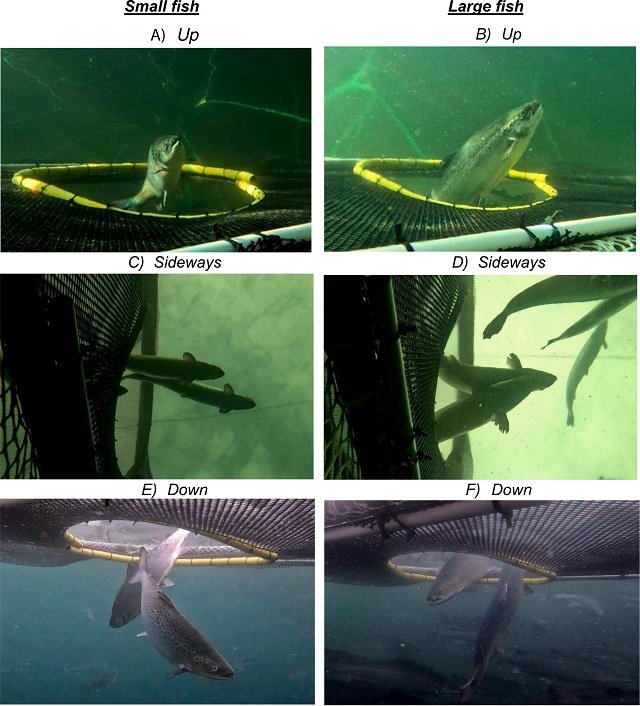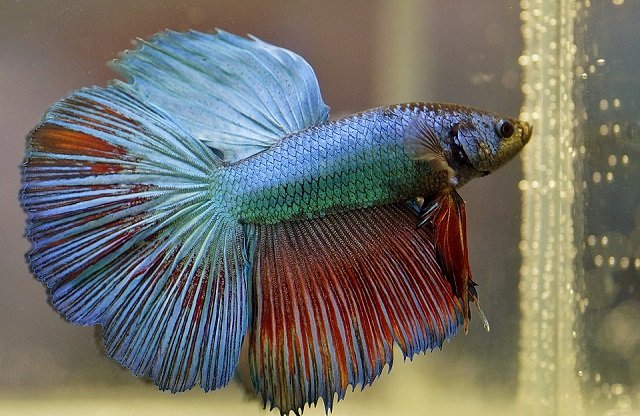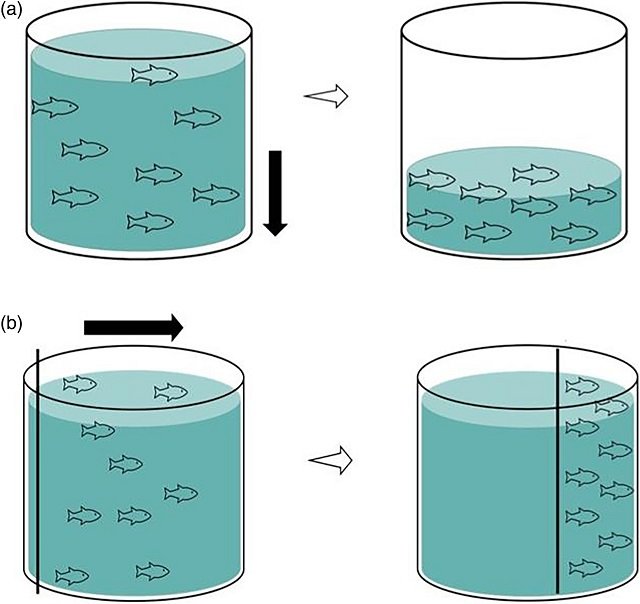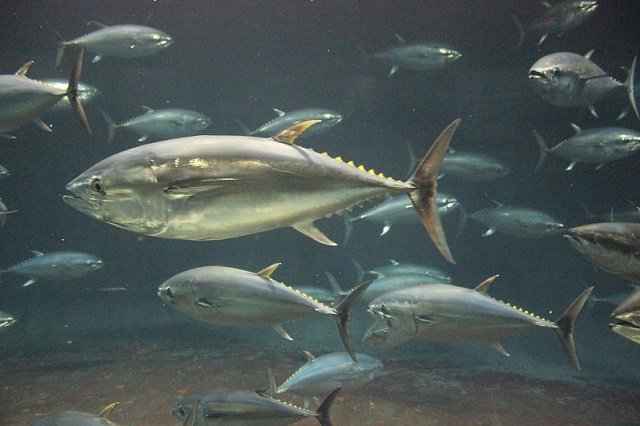
Salmon aquaculture is advancing towards larger, more complex structures located in offshore or submerged environments. These new designs, though promising, present a fundamental operational challenge: how to extract a portion of the biomass for treatments or harvesting efficiently and without causing undue stress to the fish?
An innovative study by researchers from the Institute of Marine Research and Deakin University, published in the journal Aquaculture, offers a compelling and elegant answer. By investigating how the direction of crowding influences the exit behavior of fish, they have shown that a simple modification in strategy can double the extraction efficiency and significantly reduce the pressure on the animals. The key is not to force, but to use the salmon’s natural behavior to our advantage.
The challenge: extracting salmon at the new frontiers of aquaculture
- 1 The challenge: extracting salmon at the new frontiers of aquaculture
- 2 An ingenious experiment: testing the direction of crowding
- 3 The superiority of sideways crowding
- 4 Why does it work so well? The natural behavior of salmon
- 5 Practical implications for the salmon industry
- 6 Conclusion
- 7 Entradas relacionadas:
Traditional cages, with their flexible net construction, allow for crowding fish at the surface for handling. However, the new rigid mega-structures and submerged cages—designed to avoid problems like sea lice that inhabit surface waters —make this method unfeasible or very complex.
Extracting salmon from depth, without lifting the cages, is a logistical and animal welfare challenge. Pumping too quickly can cause barotrauma (pressure-related damage), and the crowding process itself is one of the most stressful events in a farmed fish’s life. Therefore, finding a method for crowding at depth that is fast, low-stress, and effective is crucial for the future of salmon farming.
An ingenious experiment: testing the direction of crowding
To address this question, the researchers designed a practical and direct experiment to determine if the direction of crowding—upwards, downwards, or sideways—affected the exit rate of the salmon.
The test “cube”
The researchers used a 27 m³ prototype cubic cage with a movable wall that allowed for gradual volume reduction, simulating the crowding process. On the opposite wall, a 50 cm diameter circular opening was installed for the fish to exit. The cage could be oriented so that this exit was on the top, bottom, or side.
The participants and procedure
The study was conducted with two groups of Atlantic salmon: small fish (~1.3 kg) and large fish (~4.3 kg), both with a low initial density of 6-7 kg/m³. Over 25 minutes, the movable wall reduced the cage volume at 5-minute intervals, progressively increasing the density and motivating the fish to seek the exit. A GoPro camera recorded how many fish exited and their behavior.
Stay Always Informed
Join our communities to instantly receive the most important news, reports, and analysis from the aquaculture industry.
The superiority of sideways crowding
The study’s findings were clear and unequivocal, demonstrating that the direction of crowding has a massive impact on extraction efficiency.
Almost double the fish extracted
Sideways crowding was, by far, the most successful method. Approximately 80% of the salmon (both large and small) exited the cage when the opening was on the side. In comparison, only between 20% and 50% of the fish exited when the crowding pushed them upwards or downwards. For large fish, the sideways method was 2.3 times more effective than the upward method and 1.9 times more than the downward one.
Lower stress and lower density
Perhaps the most important finding for animal welfare is that sideways crowding was much less intense. The maximum density reached during sideways crowding was only 37-43 kg/m³. In contrast, with the upward and downward methods, the fish were subjected to much higher densities, up to 59-73 kg/m³, before they began to exit in significant numbers. Maintaining a low density during handling is key to reducing stress, which in turn can improve the fish’s resilience during transport and subsequent processing.
Why does it work so well? The natural behavior of salmon
The explanation for this stark difference lies in the fish’s own behavior and biology.
- Vision and swimming: Salmon have eyes on the sides of their heads, giving them good lateral and frontal vision, but very little direct vision downwards or upwards. Furthermore, in cages, they tend to swim in circular-shoaling patterns at a constant depth. A side exit is directly in their natural “line of sight and swimming,” making it easier to find.
- Escape behavior: The study observed that to exit upwards or downwards, the fish had to alter their normal swimming pattern. In contrast, exiting sideways was a much more natural and fluid movement. Interestingly, a typical stress response in salmon is to swim downwards, which could explain why the bottom exit was slightly more effective than the top one for the small fish.
Practical implications for the salmon industry
These results are not just an academic curiosity; they have direct and valuable implications for the design and operation of future aquaculture farms.
- Cage and extraction system design: Engineers and designers of new offshore, submerged, or closed-containment systems (CCS) should incorporate mechanisms that facilitate sideways crowding towards an extraction point. This could greatly simplify harvesting and treatment operations.
- Animal welfare as a priority: Adopting sideways crowding allows fish to be handled with significantly less pressure, meeting growing animal welfare standards. Furthermore, lower stress during harvesting can have positive effects on the final product quality.
- Escape prevention: The study offers an indirect but crucial lesson on cage safety. It shows that salmon are much more likely to find and use an opening in the side walls than in the roof or bottom of the cage. This suggests that the structural integrity of the side walls is especially critical for preventing escapes.
Conclusion
The study by Warren-Myers et al. is a perfect example of how observing animal behavior can lead to simpler and more effective technological solutions. It demonstrates that to improve salmon extraction in the complex farming systems of the future, the best strategy is to align technology with the fish’s biology.
Sideways crowding is not only more efficient in terms of fish extracted over time, but it also does so at lower densities, promoting greater welfare. This approach represents a step forward towards a more sustainable, productive, and, above all, more humane salmon farming industry.
Contact
F. Warren-Myers
Sustainable Aquaculture Laboratory – Temperate and Tropical (SALTT), Deakin University
Victoria 3010, Australia
Email: fletcher.w@deakin.edu.au
Reference (open access)
Warren-Myers, F., Folkedal, O., Nola, V., & Oppedal, F. (2025). Sideways exit during crowding utilises natural salmon behaviour for easier transfer. Aquaculture, 742939. https://doi.org/10.1016/j.aquaculture.2025.742939
Editor at the digital magazine AquaHoy. He holds a degree in Aquaculture Biology from the National University of Santa (UNS) and a Master’s degree in Science and Innovation Management from the Polytechnic University of Valencia, with postgraduate diplomas in Business Innovation and Innovation Management. He possesses extensive experience in the aquaculture and fisheries sector, having led the Fisheries Innovation Unit of the National Program for Innovation in Fisheries and Aquaculture (PNIPA). He has served as a senior consultant in technology watch, an innovation project formulator and advisor, and a lecturer at UNS. He is a member of the Peruvian College of Biologists and was recognized by the World Aquaculture Society (WAS) in 2016 for his contribution to aquaculture.




